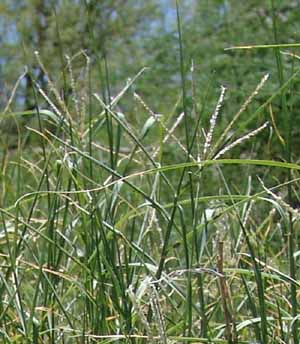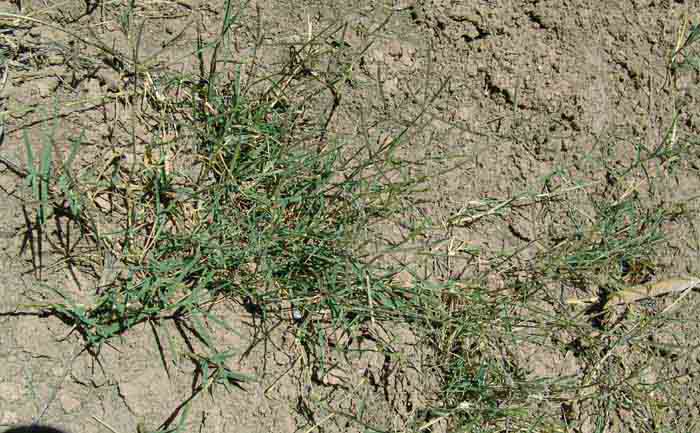
Bermuda Grass (Cynodon dactylon)
 comes from India by way of the Savannahs of East Africa and the Transatlantic Slave Trade. Now found in warm climates all over the world, it was introduced from Bermuda (hence its name) into Georgia in the 18th century and spread to the west coast with the Gold Rush in the 1850s. It is now everywhere in the lower elevations of Arizona.
comes from India by way of the Savannahs of East Africa and the Transatlantic Slave Trade. Now found in warm climates all over the world, it was introduced from Bermuda (hence its name) into Georgia in the 18th century and spread to the west coast with the Gold Rush in the 1850s. It is now everywhere in the lower elevations of Arizona.
Above, in the top-banner photo, a stand of Bermuda in an old earthen Tank on Soza Mesa, in February of 2004. This grass has probably survived at this location without further human intervention (following building of the tank and seeding of the grass) for some 50 years. At left, a closeup showing the distinctive inflorescences, characterized by seeds borne on four or five narrow branches that spread fingerlike from the tip of short leafless stalks, from the Diversion Tank in May 2004, after the good spring rains. (Click on the image to enlarge it.)
A very hardy perennial, creeping grass with a deep root system, it reproduces through seeds, runners, and rhyzomes. It moves fast: it can put out seeds within three months of implantation, the seeds germinate when temperatures reach 68 degrees F., and will begin growing within two weeks. Though it prefers 16"+ of rain per year, once established it is highly resistant to drought (going into dormancy above-ground while its rhizomes extend toward the water table), it can spread in poor soils, and it is strongly fire-adapted. Its flowering season is long (September through May), a problem to allergy sufferers since its pollens are highly allergenic.
Below, a view of the spreading grass from directly above (in the clayey bottom of the Diversion Tank), showing the sprawling reach of the above-ground runners. (Click on the image for a close-up view.)

Bermuda grass was, however, sacred to the Hindus in India because it was such important and preferred feed for their cows, and it is valued by American farmers for these reasons as well. It is also valued as an erosion control because of the tough, tight mats it forms as sod. Hence people hold ambiguous views about its status as an invasive -- much depends on its performance in specific situations. Around our existing watertanks, for example, Bermuda is well established, and provides forage for cows, deer, and other animals alike. It would seem a misallocation of labor and other resources to try to remove it in such locations.